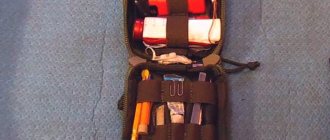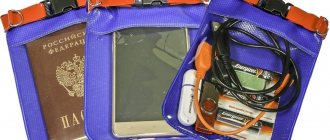The material contains a list of necessary things, compiled in advance and used for their intended purpose in the event of an unforeseen emergency, natural disaster, emergency or martial law. Among employees and workers of the Russian Ministry of Emergency Situations, this kit also bears the following names: “alarm suitcase”, “alarm suitcase”, “alarm backpack”, “thing bag”, “GO suitcase” next - the kit.
Approximate list (list) of necessary items in the essential kit
The general list of things included in the emergency suitcase for military personnel and employees of the Ministry of Emergency Situations includes the following items:
- A badge indicating your personal number (name tag).
- Personal protective equipment.
- Map of the district, city, region.
- A set of simple pencils and automatic pens.
- Employee's passport, passes, ID, driver's license, other documents (if necessary).
- Commander type line.
- Compass.
- Knife (penknife).
- Change of set of things.
- Socks, needles, threads, handkerchiefs.
- A set of food for seventy-two hours.
- Toiletries and tableware.
- Candle, flashlight, matches.
- Envelopes, notebook.
If the management of the relevant department issues an order, this list may be supplemented with other items.
List of things needed in an emergency suitcase
There is a difference between the emergency suitcase of the Ministry of Internal Affairs, the alarm suitcase of the Ministry of Emergency Situations or for employees of various ministries, where the set of things is determined by the relevant orders of the leaders, depends on the type of department and the tasks assigned to it, and the civilian one, which is collected by the population. Although, the basic composition of the alarm backpack is the same:
- documentation;
- means to stay connected;
- first aid kit;
- personal hygiene products;
- water and a minimum set of food;
- navigation devices for terrain orientation;
- bivouac equipment;
- household consumables;
- individual protection means.
A serviceman's emergency suitcase, among other things, includes a badge with an individual number, as well as the leadership of the Ministry of Internal Affairs, the Federal Penitentiary Service (Federal Penitentiary Service) and other services; additional lists of things can be added that correspond to the task, location, etc.
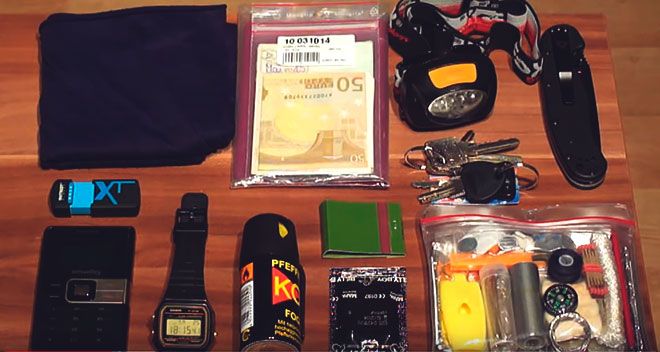
The contents of the backpack can be expanded.
Depending on your location, the nature of the disaster, and the presence of children, the contents of the backpack may expand. However, this set is a base, the presence of which will make it possible to survive in any conditions for the first 72 hours (the time necessary, according to experts, for the Ministry of Emergency Situations staff to restore normal operation of life support systems).
List of additional things
In most cases, the backpack (bag) itself is not included in the emergency suitcase of a military personnel and an employee of the Ministry of Emergency Situations. Its volume must be at least thirty liters. It should have comfortable straps (handles) and enough additional fasteners.
Since an emergency situation involves possible long-term movement with this luggage, it is best to choose a backpack that, in addition to two straps, has body (waist) fasteners that help lighten the weight.

In addition to the container itself, an important element of the emergency suitcase of a soldier or an employee of the Ministry of Emergency Situations is a first aid kit. In it, in addition to first aid supplies, each owner of the backpack collects the medicines and medications he needs.
Food Ingredients
When considering the items included in the emergency kit, you should separate items related to nutrition into a separate group. Firstly, it is drinking water. It can be stored in a plastic bottle. Such containers are quite light and may not deteriorate for six months.
Secondly, it is important to decide on the products that will be useful on a long hike. In the event of an emergency, it is best to take with you only the essentials: salt, sugar, crackers or bread rolls, candy, stewed meat, instant noodles and cereals, and other non-perishable products.
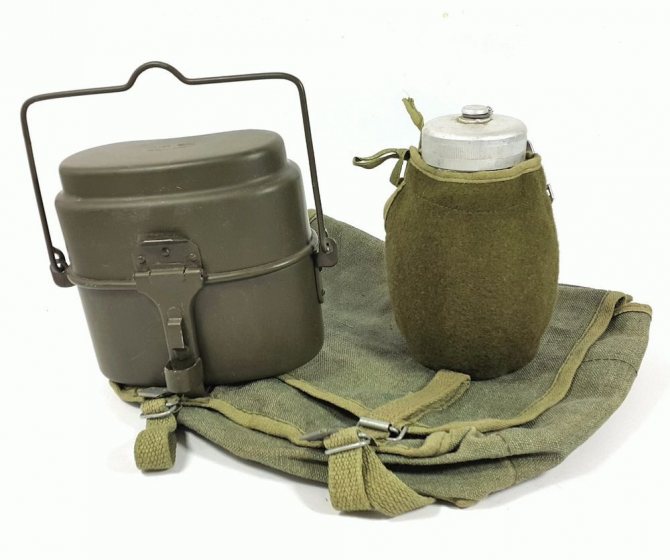
Thirdly, it is important to choose the right dishes. In the travel kit you need to store unbreakable dishes (bowl, mug, spoons, knife, fork), as well as a pot and a flask that is attached to your belt. You need to take a small, army-style bowler hat. A container like a “Soviet” pot is especially good because its lid is used as a frying pan.
Fourth, you need to take fire. The best option would be flint (lighters often fail on long trips). This also includes travel-type matches, which must be placed in a sealed, waterproof package. It’s best to stock up on dry fuel in tablets.
Emergency suitcase list
The list of items that make up the emergency suitcase of an employee of the Ministry of Emergency Situations of Russia , as mentioned above, may differ depending on the order at the place of duty. But in 99% of cases, the items included in the emergency suitcase list are the following:
- A badge on which the employee’s personal number is stamped.
- A set of personal protective equipment.
- Maps of the locality, district and region in which the service of the Ministry of Emergency Situations employee takes place.
- A set of documents, which includes a passport, ID, necessary passes to enter closed areas, and a driver’s license (if available).
- Pencils, ballpoint pen, officer's ruler.
- Compass, penknife.
- Underwear (two sets).
- Set of sewing accessories.
- The necessary set of food for survival for three days.
- Tableware (spoon, knife, etc.).
- Toiletries.
- Flashlight, boxes of matches, candles.
- A notepad or notebook for taking notes.
Personal care products
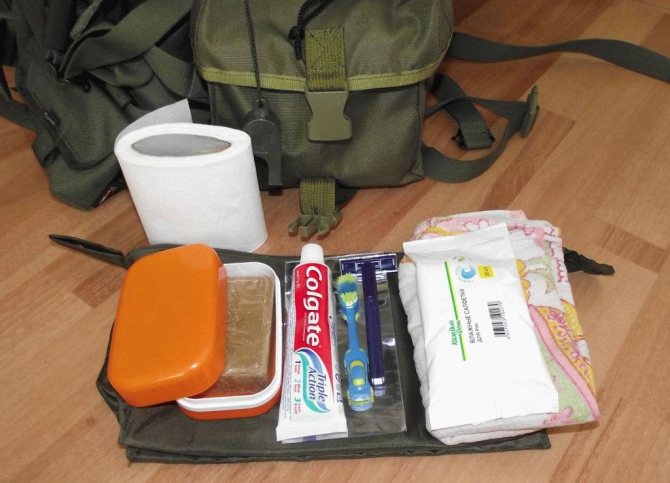
In a serviceman's emergency suitcase, the list of personal hygiene products is usually as follows:
- razor with additional removable blades (disposable razors);
- soap (liquid);
- toothbrush and toothpaste;
- rag handkerchief;
- packages of disposable napkins or scarves;
- toilet paper;
- intimate hygiene products;
- nail clippers or scissors;
- towel.
You can also supplement the list with wet wipes, cotton swabs and toothpicks (optional).
List and list of things
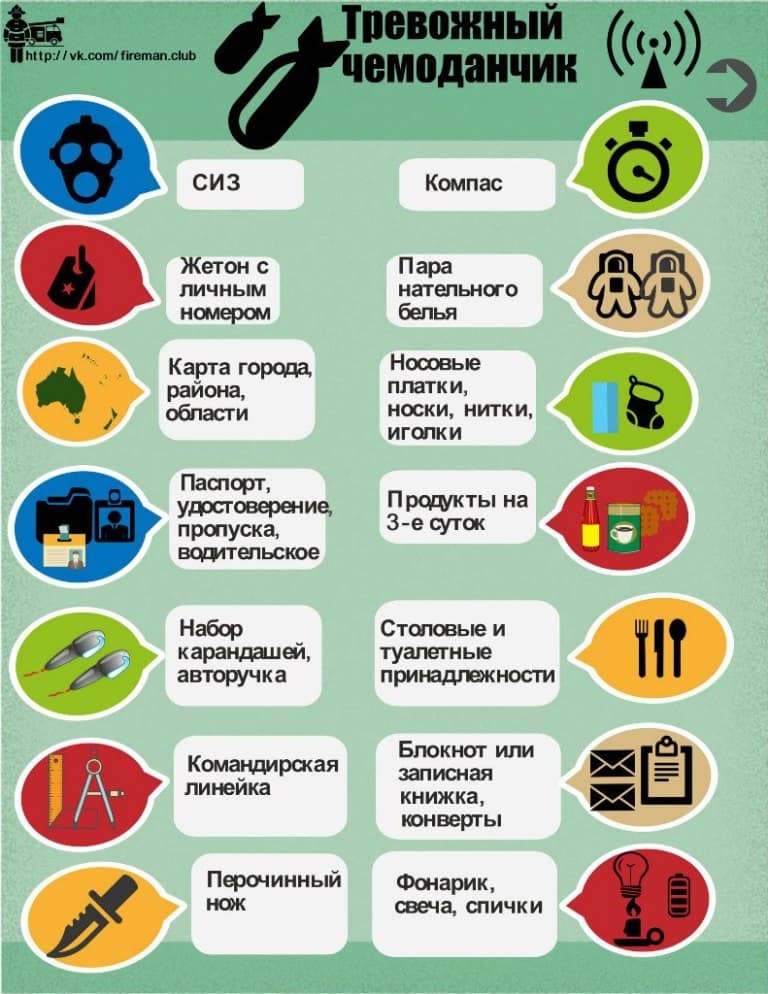
List of things in the emergency suitcase
- personal protective equipment;
- token with personal number;
- map of the city, district, region;
- passport, ID, passes, driver's license;
- set of pencils, fountain pen;
- command line;
- penknife;
- compass;
- a pair of underwear;
- handkerchiefs, socks, threads, needles;
- food for three days;
- tableware and toiletries;
- notepad or notebook, envelopes;
- flashlight, candle, matches.
And as mentioned earlier, it is possible to complete it with individual items according to the order at your place of duty*
Documents, tools and clothing
A serviceman's emergency suitcase must include the following documents: passport, passes, identification, driver's license, medical insurance, and other important papers for a citizen. They must be placed in waterproof packaging. In addition, it is advisable to make additional copies of documents and store them in another place.
It is very important to carry a variety of essential tools with you. This includes needles, threads, a knife, an ax or saw, work gloves, flashlights with batteries, and a mining shovel. It is best to choose good quality tools so that they do not break during use.
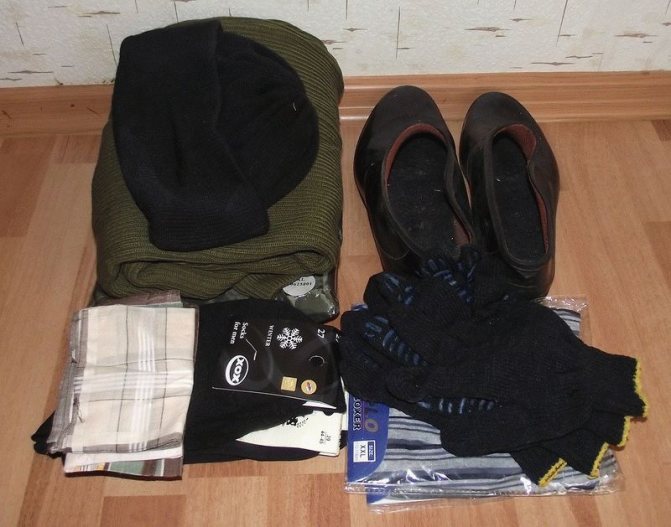
For clothes, you need to take a set of comfortable and high-quality things. It is best to choose items that have moisture-resistant and heat-saving properties. The most suitable option would be thermal underwear. Equally important are gloves, socks and a hat (preferably knitted).
Devices for communication and orientation
For emergencies, you need to purchase a mobile push-button phone with a charger (since smartphones discharge quickly, so they are of little use in emergency situations). A compact radio receiver with the ability to listen to FM or VHF waves is also useful.

A simple paper map (preferably detailed) and a compass will also be needed: any equipment, including a navigator, can fail.
An emergency suitcase is an extremely important item not only for military personnel or employees of the Ministry of Emergency Situations. It is best for every citizen to have such a kit (at least the required minimum). It will help in the event of an emergency (for example, a fire or other natural disaster).
How to pack a “worry suitcase”. Checklist of basic supplies and equipment
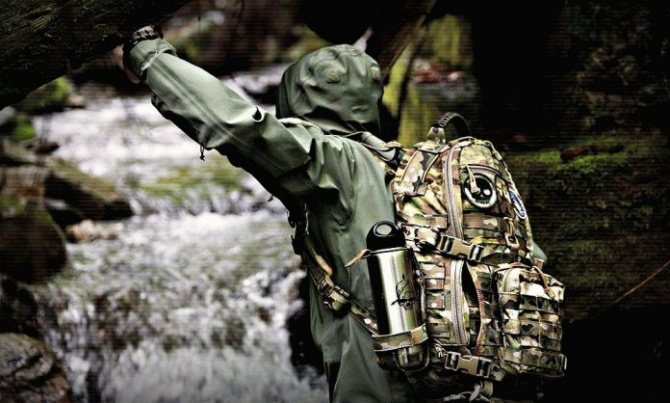
The purpose of this article is to provide all interested people with the information necessary to put together an emergency kit that will help in emergency situations.
What is a “ alarm suitcase ”? This is a backpack/bag/trunk that you have in case of unexpected incidents. This backpack should be ready to use any time you need to quickly retreat, leave a dangerous area, escape from pursuit, etc.
It has everything you need to survive a disaster for the first 3 days. You just grab your bag and try your best to get to safety.
The uniqueness of your “alarm suitcase”
The first step in assembling the ideal emergency kit is to create a comprehensive list of items needed to survive the journey to safety. It is not necessary that everything on your list be in your bag (this is impossible in principle - you will need at least a car, or better yet a truck - editor's note), but this list will give you an idea of the important contents that should ideally be in your bag. bag.
Our main goal is to offer information to help you understand where to start. There is too much information about alarm kits on websites. This information is both correct and incorrect. This post will help you find the right way to start collecting the things you need.
Since the only person who knows you well and has an idea of what items are vital to you on a daily basis is YOU, it will be easy for YOU to make a list of such items. Making such a list should not be just a funny and exciting activity for you.
This is important to know: Minimum length of special service for federal employees
This activity will really engage your brain... so don't slack off. You'll be able to breathe a sigh of relief once you've made a list of what you need because you'll be ready to handle any disaster that might come your way.
When making a list, simply think through your day and write down everything you need during a typical day. What other items will you need if you live outdoors? What would you take if it was particularly hot/cold/humid outside? Write down everything you can think of.
The perfect backpack for your emergency kit
When choosing a bag or backpack, there are three main aspects to consider: size, durability and functionality.
You'll need a container that can hold everything you need, so don't even bother choosing a bag until you've made a list of the items you'll need and gathered your supplies. Of course, most likely, you will try to buy the smallest and most compact items possible, but you will not know in advance how large the backpack will need to be to accommodate it all.
Your equipment should be able to withstand any weather conditions. A backpack that easily absorbs moisture or breaks quickly is unlikely to do you much good. You must pay special attention to the fabric so that it can protect its contents and remain wearable even in the most incredible and emergency situations.
Lastly, you will need a backpack that is easy to use. One giant compartment is not practical. You don’t want to spend a lot of time looking for something at the bottom when you desperately need this item (literally and figuratively). A bag with many pockets and compartments will be much more convenient.
So let's get to the main point
Basic Items Your Emergency Bag Should Contain
Expert opinion
Grigoriev Pavel Kirillovich
Head of the department for conscription of citizens for military service of the Russian Federation
Here we will list all the items necessary for an ordinary person. But as we said, feel free to add your own ideas or cross off anything you absolutely don't need from the list.
Water, drinking and water filtration products
The most important items to have in your emergency kit are those that will help maintain fluid balance in your body. This is because you can live up to 3 weeks without food, but you can only withstand a lack of water for 72 hours.
Therefore, water should definitely be present in your emergency kit. The minimum dose of water is one liter per day per person.
Below are the items we recommend for storing and carrying water:
- 3 liters of water
- Durable water bottle
- Water purification tablets, maximum 3
- Metal water bottle
- Filters for removing contaminants from water
- Collapsible water bottle
It is also highly recommended to have a Lifestraw filter or two with you. Lifestraws are compact, lightweight devices that help in water filtration.
You can use them to filter 99.9% of germs and bacteria in water. This means you don't have to worry about boiling or treating any water you might find before drinking it.
Another great thing about the company that makes these filters is that they help provide clean drinking water to poor countries. The company guarantees that with every purchase it provides such countries with free filtration products.
Food and something to cook it with
Food is also an important, even mandatory item in your backpack. Many survivalist communities are convinced that they need to stock up on freeze-dried foods (these are ready-made meals that are specially dehydrated).
Unlike these experts, we recommend adding a little variety to your food list. Your foods shouldn't be perishable, and you should also combine foods that require water to cook with those that don't.
This is because you don't know how bad the water situation might be where you end up, because if you don't have enough water, then dehydrated food is simply useless, so be sure to take more supplies that can be cooked without water.
Currently, most of the products we recommend are self-explanatory, but in the future, when we do in-depth reviews of alarm kits, we will go into more detail about the reasons for selecting the products below. Please note that the amount of food you pack in your bag should be enough to last you three days.
Instead of using plastic utensils, we recommend using metal utensils and kitchen utensils because they are more durable than plastic options.
- Metal pan
- Portable stove
- Metal cup
- Dishwashing brush
- Can opener P-38
- Folding spoon-fork (perfect combination of spoon and fork)
- Fuel for the stove (qty. 16 tablets)
- Energy bars to provide the body with protein (qty. 6)
- Dehydrated meals (qty. 3)
Cloth
When choosing clothes for your emergency bag, make sure you choose multi-damage resistant clothing that will keep your body temperature at an optimal level at all times. We have listed a large number of weatherproof clothing that will help you maintain a consistent body temperature.
It is important to choose clothes that will actually serve you, taking into account the different climate conditions in your area. To save space, you should check your bag every six months and change your clothing supplies to suit the season.
Be sure to pack wet clothing or items that will protect you from other types of weather in your area.
You need to have two sets of clothes for every day. This will ensure that you have a dry set of clothes in case you get very wet. Wet clothing is very uncomfortable and can cause dangerous fluctuations in body temperature, leading to illness. Therefore, be sure to change it to dry.
Items we recommend:
- Convertible trousers that easily turn into shorts
- Hiking socks, preferably wool (3 pairs)
- Shemag
- Cloak
- Underwear
- Medium fleece jumper
- Lightweight long sleeve shirt
- Work gloves
- Floppy hat
Equipment for overnight stay
We recommend that your shelter and bedding be made from lightweight, compact materials. This way you can carry such important items with ease. These items may seem like overkill and a waste of space for someone with survival experience, but they are absolutely necessary.
Instead of sleeping in the bush using a pile of leaves as a pillow, you will be able to sleep well with the things we recommend. This is because a comfortable rest, both physical and mental, helps relieve a lot of stress during difficult times.
You will thank us for a good and comfortable sleep when you need to be alert and maintain stamina in an emergency all day.
We recommend having:
- Blanket
- Travel mat
- Sleeping bag/bivoyack
- Tent
Fire ignition equipment
If you find yourself in nature and can only rely on your own resources, then you need to have several ways to light a fire. The fact is that one of the methods may not give the desired result - the fire will not light up, so if you do not have the second option, surviving will become much more difficult (especially if it is cold around).
All basic fire starting supplies should be included in your fire alarm kit. Yes, take three of each, because this way the probability of failure will be extremely small.
- Flint, tinder (quantity - 3 pcs.)
- Matches / lighter or any other tool for ignition (qty. - 3)
- Waterproof storage for heat sources
First aid kit
Unfortunately, most emergency kits are not capable of functioning as a survival kit because the equipment they contain is not designed to be used when other items for more serious medical care are not nearby. First aid is an incredibly large topic that can be discussed another time.
Expert opinion
Grigoriev Pavel Kirillovich
Head of the department for conscription of citizens for military service of the Russian Federation
Now we will limit ourselves to just one recommendation. We have one first aid tool that we highly recommend having with you, and it is listed below.
This is important to know: Sanatorium and resort treatment for military personnel
Along with it are 2 good additions. Of course, don't limit yourself to our recommendations.
This is YOUR emergency kit, and of course YOU may need certain items that we haven't included on our list.
- Field first aid kit/first aid kit
- Rescue blanket
- Insect repellent
And don’t forget that if any medications are prescribed to you by your doctor or you simply take some medication every day, then you also need to take it with you. By the way, this is another item in your bag that you will be required to replace every six months.
You don't want to be in an emergency and find that the prescription medication you packed in your emergency kit has expired. You need to be in the best possible condition when an emergency occurs, so taking care of any medical conditions you have should be a high priority.
Personal care products
Lack of personal hygiene leads to bacterial infections, which ultimately lead to deterioration of your health. An emergency kit, which we call an “emergency case,” is no exception to the rule.
If everything around you is going to hell and you are in danger, this does not mean that you can forget about hygiene. Most people forget about some essential personal hygiene supplies, so we have listed the most essential items that you simply must take with you.
- Travel-grade toilet paper (2 rolls)
- An appropriate size toothbrush and toothpaste for travel
- Toothpicks
- Small package of towels
- Hygiene/signal mirror
- Napkins
- Disinfectant
- Soap for camp
- Tampons and pads
- Deodorant
Tools
Apart from guns, people also like to buy a variety of different types of tools. After all, you never know what you might need.
But you can't pack an entire set of tools in your bag. Choose the most important ones, those that suit the terrain and conditions you are in, and forget about the others unless you have extra space.
We recommend the following three tools to have in your bag.
Lighting
It's very likely that you don't have excellent night vision. This is an aggravating factor when traveling at night, since you don't know whether you will continue moving after dark or not.
As with fire starters, we recommend having several alternatives. If one (or more) of the lighting methods doesn't work, it's important to have a backup option.
Batteries are the common denominator and should never be forgotten. All the items listed below serve the same purpose, even if they have multiple uses.
- Batteries for powering various light sources
- LED flashlight keychain
- Candles
- Small LED flashlight
- Headlamp
- Glowing sticks
Means of communication
The following equipment may come in handy if you want to stay connected even in extreme conditions. While you may not use the items listed below in some scenarios, it would be wise to use them in situations where it is safe to do so.
- Emergency radio with manual charging
- Cellular telephone
- Satellite phone
- Battery that can be charged mechanically
Travel Equipment
To avoid problems with navigation, it is important to have the following items in your bag because you never know where the road will take you and what terrain you will end up in. These items can help you find or buy your way in a variety of environments.
- Compass
- Minimum $500 in small bills
- Local map
- Gold/silver coins
- Emergency whistle
- Quarters, 8 pcs. (25 cent coins - editor's note)
- Small Notepad and Pencil
Self-defense
Self-defense and self-defense is a sensitive topic of discussion, and from what we have seen and experienced, preppers are most focused on this category.
And, yes, running away from danger is essentially a “live or die” situation. If you find yourself in the wild, you will need to survive.
We hope this never leads to conflict between people, but no matter the threat, you should have some kind of weapon to protect yourself. Below are some of the most important items we recommend you include in your emergency bag for self-defense in emergency situations.
If you prefer not to carry a gun or are not authorized to carry one, you will need some experience in gun training, especially if you are the leader of a group of people who expect you to protect and keep them safe.
- Pepper spray
- Taser/shocker
- Gun
- Rifle
- Ammunition for both types of firearms (quantity - minimum 25 rounds)
Additional items
These are items that don't fall into the categories we mentioned above, but are also important to include in your emergency kit if you still have room.
- Cotton bandana
- Mask
- Condoms (without lubricant)
- Parachute lines (paracord)
- Sunglasses
- Electrical tape, scotch tape
- Binoculars
- Sewing kit
- Resealable bags (qty. 5, various sizes)
- Latex tubes
- Face paint
- Garbage bag 30 l (qty. - 2)
- Fishing kit
- Wire
Make a personal emergency bag for each member of your family
We've consulted with a lot of experts to make sure we've listed the best educational information on what you need in an emergency. But we understand that there may be some things on this list that you will never need in your area.
There may also be some things that you will never use even if you need them. This is fine.
Adjust this list to suit your environment and ethics.
While we recommend items from the list above, we do not consider it definitive. You know yourself best, and it is equally important for you and your loved ones to decide what items you want to include in your alarm kits.
Expert opinion
Grigoriev Pavel Kirillovich
Head of the department for conscription of citizens for military service of the Russian Federation
Please note that your survival kit alone is not enough to protect you from death. The Trouble Case only gives you the best chance of surviving a bad situation.
In order to get the most out of the items in your backpack, you must know how to use them. Practice using them regularly when preparing for a real emergency.
Otherwise your kit will be useless.
As a final word for this post, we must emphasize that the alarm kit is not a family kit. Every person, even a small child, should have his own personal emergency suitcase, with his personal belongings.
This way, whoever survives the initial disaster can take their backpack and get out. You don't want your emergency bag to be filled with things that don't belong to you or items you can't use.
And you definitely don't want your materials to be too thin/in small quantities with the expectation of carrying everything your entire family needs in one "basket." You won't be able to fit as much as you need for more than one person.
Personalize and pack backpacks for each member of your family so everyone has the best chance of survival.
If you remember that emergency preparedness is a way of life, not a hobby, you will always be prepared for any situation.
Features of the emergency suitcase for the Ministry of Emergency Situations, the Ministry of Internal Affairs and other departments
Any set of emergency suitcase, regardless of its origin, be it a suitcase for the civilian population, employees of the Ministry of Emergency Situations, the Ministry of Internal Affairs or other departments, has a number of important features.
Dishes. You can supplement the standard set of utensils, consisting of a knife, spoon, bowl and mug, with an army cauldron, the lid of which can be used as a frying pan or plate.
Drinking water. It is better to use plastic containers to store water; it will retain all its taste for six months.
Fire. It is irrational to take lighters in an emergency suitcase, no matter how high quality they are. At low temperatures, gas tends to compress, which can make it difficult to light a lighter. The ideal solution is flint. More often they use travel matches, which are hermetically sealed to avoid getting wet. If damp matches do not lose their original properties, then removing the boxes can cause a lot of trouble in the future.
Products. The “extreme” diet includes products with a long shelf life: stewed meat, instant noodles, diet bread, etc. Your own food set is often replaced with army dry rations; Each package is designed for daily consumption and contains all the microelements and vitamins necessary for the human body.
First aid kit. The composition of a traveling first aid kit consists of a standard list of medications and supplies necessary for the owner of a “GO suitcase.” It is worth clearly understanding that the first aid kit is individual for each EMERCOM employee.
An alarm case is a unique tool that can save a person’s life and health in the most difficult conditions. Neglecting the rules for its configuration can cause dire consequences, therefore, the units of the Russian Ministry of Emergency Situations pay special attention to this issue, constantly improving the set of items included in it.
Article sent by: Wladimir01
I like (24)
Articles on the topic
0 33

Fire safety in primary school
Published: March 15, 2017
Instructions
Emergency suitcase in case of war and emergency
The country's leadership is trying to mask the severe crisis in the Russian economy with external threats. The conflict with Turkey showed that such a policy is very dangerous.
Military personnel never tire of repeating: “the threat of war always exists.” This means that, despite all the apparent external well-being, it will never be superfluous to have a set of means for emergency evacuation, which, by the way, is needed not only in case of a sudden war, but also in any other emergency.
And in the context of “war rumors,” it is even more necessary to think about security. People who have children should take an even more responsible approach to collecting an emergency suitcase.
This is important to know: Where can you go after the army?
The information presented in the article should in no way contribute to the development of panic. On the contrary, psychologists argue that people who have not isolated themselves from information about actions during the outbreak of war or other emergency situations, but have studied the issue in detail in advance, are calmer.
The level of anxiety of such people during the outbreak of war or during disasters is much lower than that of unprepared people.
We recommend the site “Terrible Days” - a new project of the group of anti-crisis sites “Perezhit.ru”.
So, moving on to the list of things in an emergency suitcase that needs to be prepared “just in case,” it should be noted that in each family it will look different, based on the needs of its members. An emergency kit or backpack (an emergency suitcase) is a set of things for use in case of an emergency.
A backpack (yes, it is better to buy a backpack for these purposes) should not be very large, but it must be filled with the most necessary things. Try not to overload your emergency suitcase with things.
Staying alive: how to properly assemble an “alarm backpack”
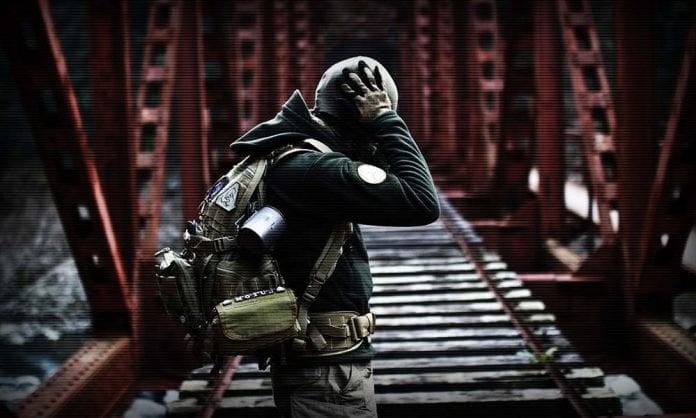
“ Alarm kit ”, “ Alarm backpack ”, or “ Alarm suitcase ” - you can have different names for an officer’s emergency kit lying peacefully somewhere in a secluded place. A minimum set of things, first aid equipment and knowledge of basic survival skills provide, as the military says, a “guarantee of safety” in the event of an emergency.
Alarm Kit is over a hundred years old. Ever since the beginning of the First World War, in descriptions of military operations there have been so-called “ sets of necessity ” - a set of things wrapped up with anything for the sole purpose of survival . emergency evacuation kit It still includes documents, personal hygiene products and a small set of food that will allow you to live autonomously for some time. However, the technological breakthrough that humanity has made in the last hundred years has certainly made its own adjustments to the contents of the “ alarm suitcase .”
The content of the article
Container
The backpack should be spacious enough, waterproof and with a comfortable suspension system.
The presence of external pockets/attachment systems is welcome. Unlike the belongings that people caught in war or other unexpected grief collected in a hurry a hundred years ago, a modern “speed dial” can be properly picked up in only a few hours. Those for whom surviving is a job are better versed in how to properly pack personal belongings and vital supplies. The military often advises: keep gunpowder and all personal belongings dry. According to the advice of military personnel from one of the special forces of the Russian Ministry of Defense, it is best to start by choosing the backpack , which will serve as a container for safe storage: the stronger the material, the better. Rubberized backpacks are well suited - with such products you can even overcome small water obstacles. backpacks are also very suitable - their corners and contact surfaces are rigid, which means they are wear-resistant and less susceptible to mechanical damage.
Documents and communication come first
“It is unknown what will happen to you, you need to prepare for everything a little,” advises special forces physical training instructor Nikolai Mukhin.
When choosing radio stations, be guided by their reliability and security, operating frequency range and battery capacity
. For emergencies of any nature, and especially man-made disasters, the “ alarm set ” should include a huge variety of things. The first thing you need to prepare is originals and copies of all important documents in waterproof packaging. Copies of your passport, driver's license, military ID, if you have one, insurance policy and similar things that will allow you to establish your identity as soon as possible. A bag with a sealed plastic zipper is best. When preparing documents, you should remember that they should be in a separate pocket of the backpack so that, if necessary, they can be quickly removed.
After the documents are prepared and packed, you can move on to other, no less important details. Emergency events, be it military operations or a man-made disaster , can unfold quickly and it is unknown how much time you will have to spend outside your home. Therefore, you need to take care of power sources for your electronic devices in advance: purchase an additional battery (or better yet, two or three) and fully charge it. Batteries and other power sources are equally important. Most city dwellers use smartphones with power sources that cannot be removed and replaced, so you should make sure that you have a basic mobile phone with a charger. You can find one at any cellular store and the price will be low.
Personal items
A multi-tool is a great help in solving most repair tasks.
In addition, it will replace a knife and help in many problems. Regardless of what time of day you received alarming information about the need to evacuate, stock up on flashlights or other lighting sources. An LED flashlight, of which there are plenty in stores, is well suited as an “emergency” flashlight. It is significantly brighter than usual with an incandescent lamp. A compass and watch are equally important components of your kit. It's best if they are waterproof. The next item is a map of the area in which you live. For residents of large cities, a detailed map indicating important administrative buildings is desirable - they are guaranteed to provide shelter or obtain information about the current situation.
You should also acquire such a universal tool as a multitool . This is something between a universal set of household tools and a Swiss folding knife “10 in one” - such a tool it will undoubtedly come in handy for use in emergency situations A knife, screwdriver, scissors are just a small part of what modern multitools . The presence of such a device in your kit is guaranteed to help you open, chop, cut or bite this or that material.
First aid kit
It is important not just to assemble a first aid kit, but to know the purpose and dosage of each medicine in it and be able to use all the components of your first aid kit
. In addition to the things necessary for relatively normal life, you, of course, need to collect a personal first aid kit . It is worth including a rather impressive list of drugs, but this is due to the fact that you will help not only yourself, but also, possibly, the people around you. Take bandages, iodine, brilliant green, cotton wool and put them away right away. Drugs to relieve intoxication, such as activated carbon - a little later. You should also find painkillers. Among other things, in the first aid kit you need to put a dozen syringes for intramuscular or intravenous injections, a solution for preparing antibiotics, and the antibiotics themselves in powder. Such a first aid kit takes up a fair amount of space, but its value is not in doubt - life is paramount, you can think about the rest a little later. Victor Satashvili, an employee of the State Healthcare Institution "Territorial Center for Disaster Medicine" admitted in an interview that the first aid kit for the "alarm kit" cannot be assembled hastily.
“It often happens that a person in a stressful situation forgets that a first aid kit can save a life. Civilians take whatever they want with them, but they most often forget the first aid kit The military know their stuff and each of my friends, for example, has special kits ready for such cases, which include everything from dressings to syringes and strong antibiotics. There are no trifles here, the first aid kit must be prepared carefully,” Satashvili emphasized.
Particular attention should be paid to those medications that you take on an ongoing basis, such as insulin for diabetics or inhalers for asthma. Calculate how much of the drug you need for a week or two and collect the required amount in advance.
Nutrition
Perhaps the most difficult element of the “ alarm kit ” is nutrition, because each person eats different foods. But even in this case, the military has simple and clear recommendations.
“Now you can easily purchase an emergency food ration , or an individual food ration (the so-called IRP ), which have a long shelf life and contain almost the entire range of nutrients vital for humans,” said an instructor for operational work of civil defense and emergency situations in Khabarovsk Edge Igor Pogarin.
The choice of the “winner” is dry rations and freeze-dried foods.
Canned food and perishable foods are a thing of the past. Always pay attention to the expiration date. When collecting food supplies , you should follow three simple standards - compactness, lightness, calorie content. You should also not forget that the product should have the longest possible shelf life and light but strong packaging. It is recommended to fill your “ alarm kit ” with dried fruits - figs, dried bananas, dried apricots, raisins, and chocolate - these extremely high- calorie foods will definitely help for a couple of days, without taking up any space in your backpack . You should also acquire a special military hydrator - a cunning device that is filled with drinking water and hidden either in a special case in a backpack or under clothing. In addition to the main supply of drinking water, the hydration pack will be able to supply you with water for some time if you lose or use up the main supply. It is strictly not recommended to take canned food - the packaging of such products weighs a lot, and the shelf life is very limited. There is a high probability that such products can cause serious poisoning. Along with the food set, you should also think about vitamins - they are now in a huge assortment in any pharmacy, so buying them will not be difficult.
Special devices
In addition to dosimeters and radiometers, you may also need protective equipment - from gauze bandages to gas masks and special gloves/suits.
The choice of special equipment for survival in emergency conditions is so wide that it is unlikely to be possible to prepare for everything at once. However, most experts in preparation, both physical and psychological, assure that it is necessary to have at your disposal a dosimeter - a device that measures the level of radiation. A decent copy can be bought for $30-40. It is also necessary to have protective equipment for the organs of vision and breathing - gauze bandages, safety glasses (preferably ballistic). In case of air pollution, they will minimize the impact of harmful substances on the body.
Of course, the described elements for the “ alarm suitcase ” should be assembled arbitrarily, however, employees of the Ministry of Emergency Situations and special forces, who survival skills than others, say that the basic elements for survival are exactly the same as we described them above. When collecting your kit, remember that there are no trifles in saving both your own life and the lives of your family members. So when you pack your backpack , check it again. Or better yet, twice.
Author: Dmitry Yurov Photo: guns.ru, wikipedia.org
From the editor:
We chose this article for publication for the reason that it reflects the contents of a real alarm suitcase , previously used by officers and employees of special forces, but the article has been adjusted to take into account current realities. The components listed in this “survival kit” are selected according to two criteria - they are really necessary and, in general, they really don’t take up much space . Their purpose is to survive, maintain health, ability to live, and not be lost or unidentified.
Anticipating the mischief and angry cries of professional survivalists and “geniuses of swag, equipment and supplies”:
"What the hell?! And where is the knife , axe , machete, spear, firewood and stove, 100 liters of water, 10 kg of bandages, body armor and helmet, shotgun + 400 rounds of ammunition, tent, raincoat and dog??!“...
...we hasten to inform you that yes, the above list is, of course, not complete to the extent that we and you are accustomed to seeing such lists on sites in our field. But, let’s be honest - the list fully satisfies the requirements for a “ disturbing suitcase ” - grab-and-run, you can’t do without this, with this even more or less. Exactly what is needed for ordinary ordinary civilian human people who are not privy to the secrets of survival and the magic of survivalism.
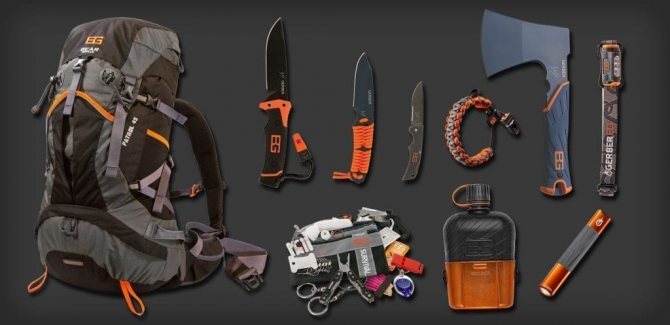
Well, for seasoned comrades we can suggest our article Alarming Suitcase - the list there is more than complete and thoughtful. Well, if you are planning to evacuate by car or even better - a truck, then we strongly recommend a very detailed list and serious advice from the article Evacuation from the city =)
Copies of documents and keys
It is necessary and mandatory to have identification documents with you in case of emergency. However, very often in a hurry the originals can be forgotten.
Expert opinion
Grigoriev Pavel Kirillovich
Head of the department for conscription of citizens for military service of the Russian Federation
Therefore, when compiling an emergency suitcase, make copies of the passports of all family members and copies of ownership documents. For men, copies of the military ID and registration certificate are required.
It is best to pack copies of documents in a waterproof file with a lock (sold in office supplies).
It is also better to make copies of car and apartment keys in advance. In the event of a quick evacuation, the originals may be forgotten at home.
First aid kit
A first aid kit is the second thing you should take care of when packing your emergency backpack. The most important ones are the medications that you or your family members take on an ongoing basis.
These could be medications that lower blood pressure, insulin, inhalers, etc. As a rule, the alarm backpack is designed to be used within the first 72 hours, so it is important to provide yourself with the necessary medications.
It is worth taking a particularly responsible approach to the selection of remedies for various poisonings and intoxications. People who have been in extreme conditions noted that often those around them simply did not have enough basic means against diarrhea that arose in unsanitary conditions or as a result of a nervous disorder.
As a basis for a first aid kit, you can take an old type car first aid kit or products from it.
The first aid kit should also include:
- bandages, iodine, hemostatic dressings
- hemostatic tourniquet
- bactericidal adhesive plaster (packaging)
- adhesive plaster roll
- painkillers, antipyretic tablets (two in one)
- drugs used for various intoxications and poisonings (enterodes, smecta, rehydron, loperamide, activated carbon)
- syringes (insulin and regular)
- antibiotics and broad-spectrum antimicrobials (ciprofloxacin, tsifran, metronidazole)
- corvalol or valerian tablets (will help you fall asleep quickly)
- antihistamines
Medicines must be packaged in a sealed bag.
So, what is a panic suitcase?
An emergency suitcase is a set of essentials that will be required for survival in extreme conditions not only for military personnel, but also for civilians.
As a rule, despite the name, this is a backpack with a volume of at least 30 liters, in which documents, medicines, hygiene products, a certain set of products, etc. are packed. Since this item is used only in emergency cases, when the reaction must be lightning fast , it is better if it is collected in advance and placed in an accessible but secluded place.
Food and water
A person can live no more than three days without water. However, this figure largely depends on external factors (ambient temperature, weather, speed of movement, terrain).
You can put 1 liter of water in your emergency backpack for each family member. Travel and sporting goods stores also now sell collapsible water flasks that look like hot water bottles.
Their weight is about 50 g, they also have a hole for draining and collecting water. Hanging on a tree, you can use these flasks as a washbasin.
The most difficult thing when packing an emergency suitcase is choosing food. However, you shouldn’t be upset here either. If it is difficult for a person to survive for more than three days without water, then without food it is quite possible to survive for more than 10 days without serious consequences.
When choosing food for an emergency, it is worth remembering three simple rules:
- Food should be light, which means dry.
- Food should be high in calories.
- Food should have a long shelf life.
Let's consider several options for dry rations
Option number 2 (budget).
Option number 3 (fast). If you did not have time to buy the products listed above in specialized stores, then you can make up a dry ration from what you have on hand. These may be the following products:
- Dried fruits (apples, pears, raisins, dried apricots, dates) are high in calories and take up little space.
- Nuts, any seeds.
- Crackers, biscuits, any dry cookies, bagels, crackers.
- Pate or porridge in aluminum packaging.
- Chocolate bars, muesli bars.
- Processed cheeses.
- Coffee, tea in bags, jelly for brewing in a mug.
- Sugar, vitamins, sweet candies.
Mini tent, foam, mat
Having a mini tent is very important as it will protect you and your belongings from the rain and can also protect you from insects. The mini-tent is a high-strength sleeping bag. The total weight of the mini-tent is about 2 kg including pegs. Instead of a mini-tent, you can take a regular tent for several family members.
To protect against cold and wet clothes while sleeping, it is also important to use foam or a mat. Currently, there are inflatable mats weighing about 200 g and costing about 300 rubles (sold in sports stores). An ordinary travel mat can be rolled up and tied to a backpack.
Change of clothes, small towel
An emergency can happen at any time of the year, and it’s always possible to add the necessary clothing to your backpack before heading out.
- A rain cover is essential for a backpack for such situations. At the right time, it can protect you, your backpack, and several raincoats tied together can act as a kind of awning. Instead of a raincoat, a light waterproof jacket is suitable.
- Choose clothes in basic colors (black, gray, brown), avoid camouflage colors. At the time of evacuation, you may be mistaken for a military man.
- Purchase thermal underwear (pants, T-shirt) in advance.
- The backpack should have a spare set of underwear and socks.
- Hat and gloves.
- Handkerchiefs (white)
At the time of evacuation, a white handkerchief can be tied to your backpack, signaling that you are a peaceful civilian.
Personal items that need to be collected in an emergency suitcase
- For items, throw in two sets of underwear and socks. Handkerchiefs are also included in several pieces.
- Paper napkins and handkerchiefs are a different matter, and there won’t be enough of them either.
- Among the things it is impossible to give exact recommendations, because everything depends on weather conditions. But a change of socks or T-shirt with shorts or sweatpants won't hurt. And it’s better to follow the rule that it can be cold at night even in the hot summer. It is important that things are made of natural fabric and dark, non-staining colors. But don’t wear camouflage colors; rescuers may mistake you for a military man.
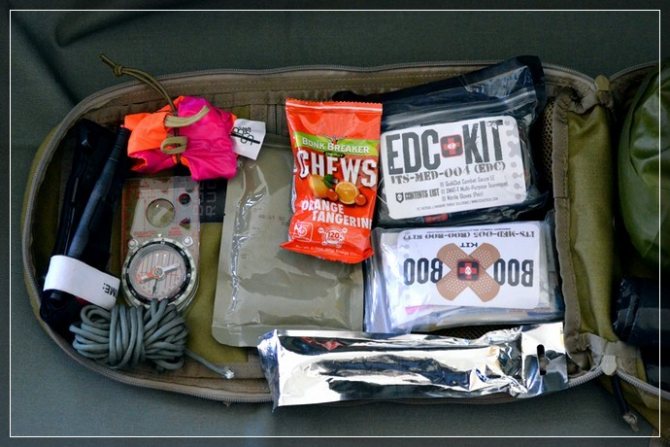
Personal hygiene products should include those items that you use. Therefore, be sure to correct the list. But here are the basic items that you may need in any situation:
- toothpaste and toothbrush;
- soap with a soap dish, preferably small in size;
- hand sanitizer will not take up much space;
- toilet paper(!) will never be superfluous, but you shouldn’t take more than two rolls;
- wet wipes. One large package of 10-15 pieces is enough. it is not advisable to take;
- take only a small towel and a quick-drying one;
- tongs and nail scissors;
- shaving foam in a small bottle and a razor;
- a mirror, since shaving will be extremely inconvenient in the reflection of the river;
- feminine personal hygiene products. These can be pads or tampons, but also no more than 2-3 packs. A reservoir or cup for critical days would be a good help in such a situation, but it requires sterilization;
- Girls, take note – you will have no use for cosmetics in case of evacuation. Therefore, you should not clutter your suitcase with unnecessary items.
Alarm suitcase: what is it and how to assemble it
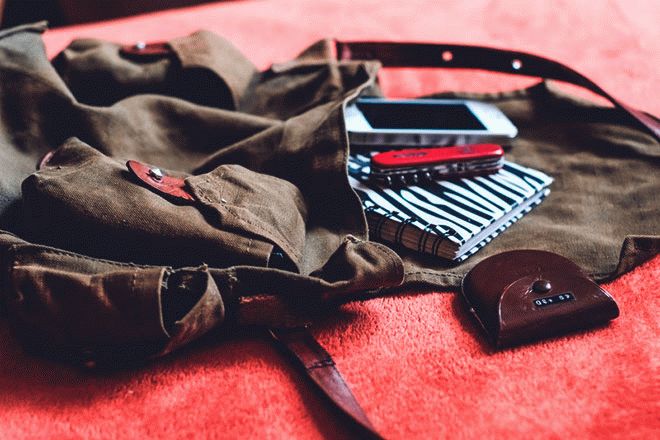
It would seem that the terms “emergency suitcase”, “emergency backpack”, “duffel bag”, “defense suitcase”, “alarm backpack” are definitions familiar only to law enforcement officers who need to carry a minimum set of necessary things in case of a quick change of tactical situation. However, people from all segments of the population may be affected by emergency situations, such as man-made disasters, natural disasters, military operations, etc., in which a pre-assembled survival kit will save precious minutes, and they can be life-saving.
What is an alarm case (TC)
Let's start with the smallest things. PM is a pre-prepared set of things that are collected in a backpack. In any emergency, it can be quickly retrieved and taken to a safe place. In general, it is a backpack with a volume of 20 to 50 liters, which contains a minimum set of things such as clothes, food, tools, and medicines. All items should be as new as possible and updated periodically. It is worth remembering that food and medicine have an expiration date, so on average once or twice a month they need to be checked and replaced with a new one. I repeat once again, PM should be in every family, it will help to leave the combat zone as quickly as possible, evacuate from an unfavorable seismic zone or flood and fire zones






